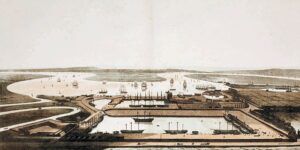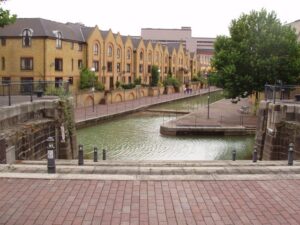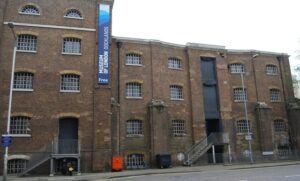A brief history of London Docklands
Date post added: 26th January 2024
Think of London Docklands and you probably picture shimmering glass skyscrapers, swanky apartments and corporate office buildings. That’s all down to its regeneration and the new beginning that the London Docklands Development Corporation defined for the area in the 1980s. But for centuries, this area on the River Thames was the main hub for British seafaring trade.
Here, we’ll look at the rise, fall and total overhaul of the London Docks and the significant part they played in London history.
Where are London Docklands?

London Docklands Map by Reveley, Willey
The London Docklands area is in the East End of London and covers 22 sq km (nearly 9 square miles). Set on the riverside, it’s centred around the boroughs of Tower Hamlets, Newham, Southwark, Lewisham and Greenwich. When you picture the River Thames as it flows through London, Docklands is in the U shaped section, before it flows out to Essex and Kent.
London Docklands: the origins
Let’s wind all the way back to Roman times. This part of the Thames was broader and shallower than it is now, so it was an ideal spot to moor a boat. That’s handy when you’re a Roman conquering Britain.
What was marshland began to be developed into fortified embankment throughout the 12th, 13th and 14th centuries. Then under Elizabeth I, legal quays were established between Tower and London Bridges. In 1696, the Howland Great Dock in Rotherhithe was built and later expanded into the Surrey Commercial Docks.
London Docklands: the 19th century boom time

East India Docks by William Daniell
In the 19th century, the British Empire was expanding, steam was powering growth and trade was on the up. Pressure on the river and dock areas grew and grew, causing massive river traffic jams which thieves used to their advantage. The Port of London wasn’t coping. The solution was to develop secure warehouses beside guarded quays, and the West India Docks opened in 1802. Three years later, London Docks opened at Wapping and the East India Docks in 1806. St Katharine Dock near Tower Bridge was established in 1828.
It still wasn’t enough to deal with the demand, so a group of entrepreneurs decided to develop something bigger and deeper than ever. With ambitious and incredible engineering, they dug docks out of the marshland further east. In 1855, Royal Victoria Dock opened with the latest technology to deal with the huge steamships transporting goods around the empire.
Vast numbers of workers were needed to move goods to and from the ships to the shore. Another aspect of this industrial boom was the rise of factories in the area. The first was Samuel Silver’s waterproof clothing company which resulted in the area being named Silvertown.
This expansion of the docks still wasn’t enough for the industrial trade in the second half of the 19th century. Development continued with Millwall Docks launching in 1868 and the Albert Dock opening in 1880. This innovative dockside development incorporated railway lines and refrigerated warehousing to preserve the imported food. The Victoria and Albert Docks were the prime sites for imported tobacco, fruit, vegetables, grain and meat, and offered huge employment opportunities. Housing was needed for the workers, and communities grew in areas such as Woolwich, Canning Town and Silvertown. This was boom time for the London docks and developments expanded down the river with Tilbury docks launching in 1886.
London Docklands: the 20th century lows and highs
In 1909 the Port of London Authority (PLA) was created to oversee the London docks. King George V recognised the London docks’ importance and pronounced them Royal Docks in 1921, including his namesake the King George V Dock. But what goes up must come down and the first half of the 20th century saw some pretty low lows for the docks. There was the General Strike in 1926 which hit the Royal Docks right where it hurt. Industrial disputes continued for some time, with unions striving for better living and working conditions for its members. Then, in 1939, World War II started and the docks were severely damaged by German bombing.
As the 20th century progressed, the docks declined, unable to adapt and evolve in line with modern technology and change. Tilbury Docks were better equipped, being in deeper water, and they took over much of the trade previously destined for the London docks further up the River Thames.
In December 1981, the final commercial vessel departed the Royal Docks. The closure of docks in London resulted in huge unemployment and social problems across East London.
Meanwhile, old industrial and residential units along the River Thames from Waterloo to Woolwich were being snapped up by investors with an eye for redevelopment.
The London Docklands Development Corporation rethink the area
As the Royal Docks were closing down, the London Docklands Development Corporation (LDDC) started to define their new plans for the now derelict area. Parliament decreed the area an enterprise zone with various incentives to attract businesses. It made it an attractive proposition for investors and a veritable property boom began.
The LDDC oversaw a huge development programme during 1980s and 1990s with swathes of the Docklands being converted into residential, commercial and light industrial spaces. One of the most notable was the Canary Wharf development on the Isle of Dogs. The modern style of stone and glass office buildings soared upwards, dominated by a central 45-storey skyscraper, One Canada Square. The area became London’s second central business district.
An intrinsic part of this redevelopment was transport. In 1987, the Docklands Light Railway (DLR) opened and connected neglected East London neighbourhoods. It started with Island Gardens, Tower Gateway and Stratford, and by 1994 it had extended out to Beckton. All of this has had a profound effect on the surrounding areas too. Take Rotherhithe for example, which has emerged Phoenix-like from its derelict 1970s past to the vibrant and smart community that it’s become.
Then in 1987, London City Airport opened on the former Royal Docks. The Limehouse Link road tunnel opened in 1993, connecting Docklands to the City of London. University of East London opened its largest campus with outstanding sports facilities on the Royal Albert Dock in 1999. And the list goes on with the underground extending out to the area, first with the Jubilee Line and then the Elizabeth Line. Plus, there’s constant development and redevelopment within the area and its surrounding neighbourhoods.
London Docklands now
One of our absolute favourite places to visit in the area is the Museum of London Docklands, located in a former warehouse in Canary Wharf. The current Fashion City exhibition is fascinating, and you can experience a proper, old school East End tailor’s!
Many of the old warehouses have been converted into urban quayside apartments. Whilst some of the docks are no more, others are now used as marinas or watersports centres.
Today, the Royal Docks is the sole Enterprise Zone in London meaning that its business rates are reinvested in the area to encourage economic growth.
The Elizabeth Line has improved connections to west and central London in minimal time. It takes a mere 18 minutes to travel between Canary Wharf and Paddington.
Walk along the Thames with us!
We run several guided walks around the Docklands area. They tend to be seasonal rather than regular walks, but please contact us if you’d like to know more about them or to arrange a tour.
Join us to discover more about:
- Limehouse – Thames – Docklands
- Royal Victoria Dock to East India Dock Towpath
- East India Docks – Thames – Docklands
- Grand Surrey Canal, Royal Navy Victualling Yard, Greenland Dock
A lovely way to take in some London riverside locations is on our Along the Thames pub walk or the Thames sightseeing river cruise. You’ll discover so much more from our knowledgeable guides than you would anywhere else. Their stories are legendary!






